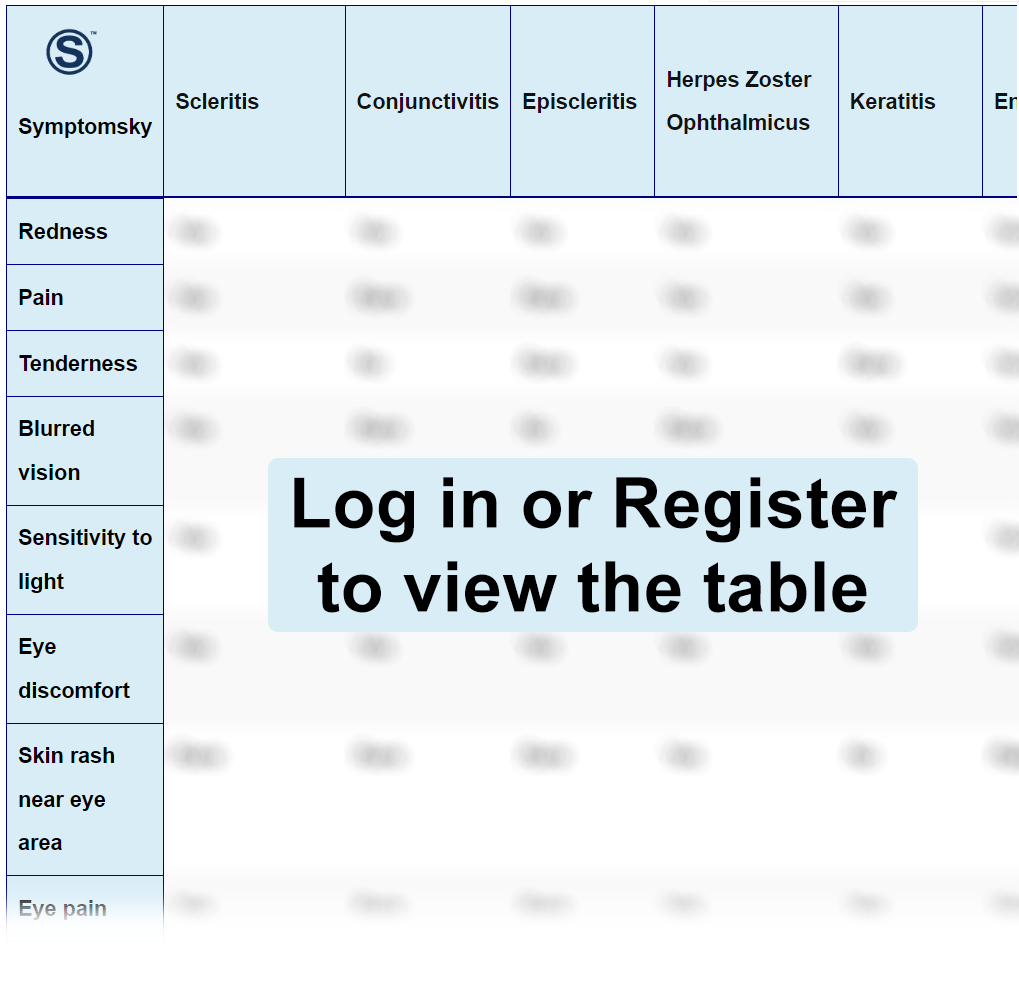Contents
Scleritis Differential Diagnosis Table:

The sclera is the support of the eyeball and is covered by the episclera, which is very vascularized. Scleritis is inflammation of the sclera. The cause is idiopathic but is often related to autoimmune diseases such as rheumatoid arthritis and systemic lupus erythematosus. It occurs most often in women between 30 and 60 years of age and is rare in children. It presents in three forms: diffuse, nodular, and necrotizing.
Symptoms of scleritis include dull pain, blurred vision, light sensitivity, and red patches on top of the sclera. The diagnosis is purely clinical, and the slit lamp is used during the clinical evaluation. In cases of posterior scleritis, the help of a tomography or ocular ultrasound is needed.
There is no specific treatment for scleritis since the causes may be diverse and therefore it will depend on the disease causing the scleritis. Before treatment, the patient will undergo ophthalmological studies as well as laboratory tests to rule out infectious diseases, but usually initially requires anti-inflammatory drugs administered orally and topically.
How To Distinguish Scleritis From Other Diseases
Distinguish Scleritis from Conjunctivitis – Diagnosis
- Conjunctivitis is the inflammation of the conjunctiva, while Scleritis is the inflammation of the sclera.
- Unlike Scleritis, Conjunctivitis is more common in children.
- Conjunctivitis is a mild condition and does not cause significant damage, unlike Scleritis, which can lead to very dangerous secondary complications such as blindness.
- Unlike Scleritis, Conjunctivitis causes phlebitis as well as increased eye discharge.
Distinguish Scleritis from Episcleritis – Diagnosis
- Episcleritis is the inflammatory condition of the episclera, while Scleritis is the inflammation of the sclera.
- Episcleritis, unlike Scleritis, is more common in young adults.
- Episcleritis does not have as much association with autoimmune diseases as Scleritis.
- In Episcleritis, unlike Scleritis, the onset of signs and symptoms is acute, and the main symptom is a mild burning sensation in the eyeball.
Distinguish Scleritis from Herpes Zoster Ophthalmicus – Diagnosis
- Although Scleritis can be a secondary cause of the herpes virus, it is not as common as Herpes Zoster Ophthalmicus.
- Herpes Zoster Ophthalmicus, unlike Scleritis, presents blisters around the upper eyelid accompanied by conjunctivitis and burning, throbbing, and itching around the eye as well as sensitivity to touch.
- Scleritis can be bilateral, unlike Herpes Zoster Ophthalmicus, which affects only one side of the face.
Distinguish Scleritis from Keratitis – Diagnosis
- Keratitis is the inflammation of the cornea, while Scleritis is the inflammation of the sclera.
- Keratitis, unlike Scleritis, presents difficulty in opening the eyelid, reduced vision, and the sensation of having something in the eye.
Distinguish Scleritis from Endophthalmitis – Diagnosis
- Endophthalmitis, unlike Scleritis, is an infection of the tissues inside the eyeball.
- Endophthalmitis is a medical emergency, while Scleritis is not.
- Unlike Scleritis, Endophthalmitis is a consequence of ocular procedures.
- Endophthalmitis, unlike Scleritis, causes decreased vision and phlebitis.
Common Red Flags with Scleritis
If Scleritis is not treated in time, the cornea may suffer secondary involvement in the periphery known as peripheral ulcerative keratitis, which may lead to perforation and loss of the eyeball. The most common scleritis is anterior scleritis. The systemic diseases most frequently associated with scleritis are systemic lupus erythematosus, polyarteritis nodosa, rheumatoid arthritis, and relapsing polychondritis.
